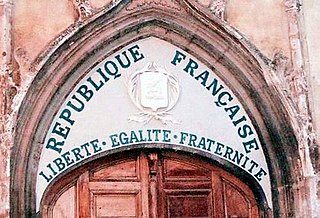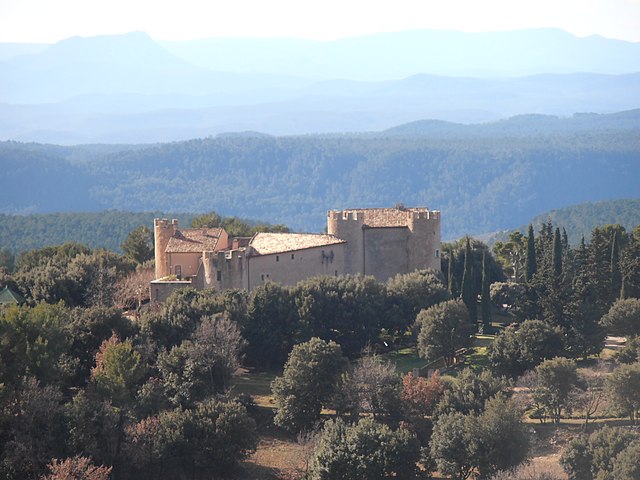Aups
Commune in Provence-Alpes-Côte d'Azur, France From Wikipedia, the free encyclopedia
Commune in Provence-Alpes-Côte d'Azur, France From Wikipedia, the free encyclopedia
Aups (French pronunciation: [ops];[3] Provençal Occitan: Aups in the classical norm, Aup in the Mistralian norm, pronounced [ˈaw])[4] is a commune in the Var department in the Provence-Alpes-Côte d'Azur region in southeastern France.
Aups | |
|---|---|
 View of Aups | |
| Coordinates: 43°37′42″N 6°13′29″E | |
| Country | France |
| Region | Provence-Alpes-Côte d'Azur |
| Department | Var |
| Arrondissement | Brignoles |
| Canton | Flayosc |
| Intercommunality | CC Lacs Gorges Verdon |
| Government | |
| • Mayor (2020–2026) | Antoine Faure[1] |
| Area 1 | 64.15 km2 (24.77 sq mi) |
| Population (2021)[2] | 2,317 |
| • Density | 36/km2 (94/sq mi) |
| Time zone | UTC+01:00 (CET) |
| • Summer (DST) | UTC+02:00 (CEST) |
| INSEE/Postal code | 83007 /83630 |
| Elevation | 390–1,077 m (1,280–3,533 ft) (avg. 505 m or 1,657 ft) |
| 1 French Land Register data, which excludes lakes, ponds, glaciers > 1 km2 (0.386 sq mi or 247 acres) and river estuaries. | |



Located in Provence at 500m alt, Aups is in the first foothills of the Alps. The town is at the gates of Verdon River, at 60 km from the sea and 80 km from the snow stations.
Aups is named Capital of Haut-Var and Capital of the truffle and was made a part of the Parc naturel régional du Verdon in 2000. Its typically Mediterranean climate makes the village a healthy place to live.
Aups has a hot-summer Mediterranean climate (Köppen climate classification Csa). The average annual temperature in Aups is 13.5 °C (56.3 °F). The average annual rainfall is 784.1 mm (30.87 in) with November as the wettest month. The temperatures are highest on average in July, at around 22.6 °C (72.7 °F), and lowest in January, at around 5.8 °C (42.4 °F). The highest temperature ever recorded in Aups was 40.1 °C (104.2 °F) on 28 June 2019; the coldest temperature ever recorded was −10.4 °C (13.3 °F) on 30 December 2005.
| Climate data for Aups (1991−2020 normals, extremes 1993−present) | |||||||||||||
|---|---|---|---|---|---|---|---|---|---|---|---|---|---|
| Month | Jan | Feb | Mar | Apr | May | Jun | Jul | Aug | Sep | Oct | Nov | Dec | Year |
| Record high °C (°F) | 23.8 (74.8) |
22.4 (72.3) |
25.9 (78.6) |
27.6 (81.7) |
33.0 (91.4) |
40.1 (104.2) |
38.7 (101.7) |
39.3 (102.7) |
34.0 (93.2) |
30.9 (87.6) |
22.7 (72.9) |
22.4 (72.3) |
40.1 (104.2) |
| Mean daily maximum °C (°F) | 10.6 (51.1) |
11.7 (53.1) |
15.1 (59.2) |
17.9 (64.2) |
22.1 (71.8) |
26.9 (80.4) |
30.2 (86.4) |
30.0 (86.0) |
24.7 (76.5) |
19.7 (67.5) |
14.1 (57.4) |
11.0 (51.8) |
19.5 (67.1) |
| Daily mean °C (°F) | 5.8 (42.4) |
6.2 (43.2) |
9.0 (48.2) |
11.8 (53.2) |
15.8 (60.4) |
19.9 (67.8) |
22.6 (72.7) |
22.5 (72.5) |
18.2 (64.8) |
14.3 (57.7) |
9.3 (48.7) |
6.5 (43.7) |
13.5 (56.3) |
| Mean daily minimum °C (°F) | 1.0 (33.8) |
0.7 (33.3) |
2.9 (37.2) |
5.7 (42.3) |
9.4 (48.9) |
12.9 (55.2) |
15.0 (59.0) |
14.9 (58.8) |
11.6 (52.9) |
8.8 (47.8) |
4.6 (40.3) |
1.9 (35.4) |
7.5 (45.5) |
| Record low °C (°F) | −9.2 (15.4) |
−10.2 (13.6) |
−10.1 (13.8) |
−3.6 (25.5) |
0.7 (33.3) |
4.5 (40.1) |
7.7 (45.9) |
7.3 (45.1) |
2.2 (36.0) |
−3.5 (25.7) |
−6.3 (20.7) |
−10.4 (13.3) |
−10.4 (13.3) |
| Average precipitation mm (inches) | 56.8 (2.24) |
42.4 (1.67) |
40.3 (1.59) |
75.8 (2.98) |
72.4 (2.85) |
56.5 (2.22) |
22.6 (0.89) |
46.7 (1.84) |
75.1 (2.96) |
102.9 (4.05) |
125.1 (4.93) |
67.5 (2.66) |
784.1 (30.87) |
| Average precipitation days (≥ 1.0 mm) | 5.6 | 5.0 | 5.4 | 7.9 | 7.4 | 4.7 | 3.0 | 4.3 | 5.5 | 6.7 | 8.4 | 6.3 | 70.1 |
| Source: Météo-France[5] | |||||||||||||
The village was named Oppidum de Alpibus (town of the Alps) then Castrum de Alpibus (fortress of the Alps), castrum de Almis, then Alps and now Aups. The place was colonized by the Oxybians (a Ligurian tribe) during the time of Ancient Rome, near Via Aurelia going from Fréjus (Forum Julii) to Riez (Forum Reii). Julius Caesar visited Aups on his way to conquering Gaul. He is supposed to have said, « I would rather be the first man in Aups than the second in Rome ».
In 1574, the town was looted by the Huguenots, who massacred 18 residents. A statue called "Maiden of the Massacre" was erected on square where the massacre took place, in Clock Street.
Aups was the centre of the Var Republican insurgency in 1851 against the coup d'état of Napoleon III, and became known as the "Center of Red Var".
Aups was a stronghold of the French Resistance during World War II. The city earned the Croix de guerre avec palmes. It was liberated by American forces on 17 August 1944, two days after the Operation Dragoon landings to the south.
| Year | Pop. | ±% p.a. |
|---|---|---|
| 1968 | 1,488 | — |
| 1975 | 1,500 | +0.11% |
| 1982 | 1,652 | +1.39% |
| 1990 | 1,796 | +1.05% |
| 1999 | 1,903 | +0.65% |
| 2007 | 2,047 | +0.92% |
| 2012 | 2,113 | +0.64% |
| 2017 | 2,228 | +1.07% |
| Source: INSEE[6] | ||
Aups has the third largest black truffle market of France, known for its quality and importance. This market is held every Thursday from November to February.
There is a colourful Provençal market, every Wednesday and Saturday featuring local products and handicrafts.
The Château de Taurenne is, without a doubt, one of the most beautiful and one of the last Var buildings dating from the Middle Ages. It is now home to an olive oil mill, with a boutique where you can find various award-winning olive oils.
Seamless Wikipedia browsing. On steroids.
Every time you click a link to Wikipedia, Wiktionary or Wikiquote in your browser's search results, it will show the modern Wikiwand interface.
Wikiwand extension is a five stars, simple, with minimum permission required to keep your browsing private, safe and transparent.